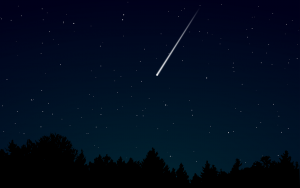17 April 2017
Why can we see and hear meteors at the same time?
Posted by Lauren Lipuma
By Lauren Lipuma
Light travels nearly a million times faster than sound. But for thousands of years, humans have reported hearing some meteors as they’re seen passing through the night sky.
A new study offers a simple explanation for this puzzling phenomenon: the sound waves aren’t coming from the meteor itself. Instead, the burning ball of rock creates radio waves that become sound waves when they strike metal structures on Earth’s surface.
Edmund Halley, namesake of the famous comet, wrote the first published account of the meteor phenomenon in 1714. In that paper, Halley described a meteor passing over Italy in 1676.
“It cannot be wondered that so great a body moving with such an incredible velocity through the air, though so much rarified as it is in its upper regions, should occasion so great a hissing noise, as to be heard at such a distance as it seems this was,” Halley wrote.
Since then, scientists have tried to explain how light and sound from the meteor seem to reach human ears simultaneously. Meteors tend to vaporize around 100 kilometers (60 miles) above Earth’s surface. At that height, it should take sound waves about 10 minutes to reach the ground.
One previous theory suggested the noise is a result of the meteor’s magnetic field becoming twisted by turbulence in its wake. Another suggested light from the meteor could heat materials like hair, clothing and leaves to produce sound.
But these theories rest on complex mathematics, and it’s more likely that a simple explanation is the key, said Michael Kelley, an ionospheric scientist at Cornell University in Ithaca, New York, and lead author of the new study published in Geophysical Research Letters, a journal of the American Geophysical Union.
Kelley points out that as a meteor vaporizes, the cloud of dust and gas that forms around its head becomes highly charged. A similar effect happens during spacecraft reentry: air molecules around the spacecraft become charged and temporarily block radio communication with returning astronauts. The cloud of charged particles around a meteor creates an electric field, the field creates a current, and the current generates radio waves that propagate to the ground.
Electromagnetic radiation like light and radio waves can sometimes be converted into audible sound in a principle known as electrophonics. Kelley’s new theory suggests metals on Earth’s surface convert radio waves generated by a meteor into sound waves people can hear.
A lot of energy gets lost in the conversion of radiation to sound, but for a meteor, the conversion only needs to have an efficiency of 0.1 percent for humans to hear it, Kelley said.
The new theory could help solve another scientific conundrum.
Indigenous peoples of the high latitudes have reported being able to hear the aurora, which are known to generate strong radio waves like meteors do. The electrophonic effect could explain how this is possible, Kelley said. He hopes the new study will inspire researchers to delve into the topic.
“It’s usually the simplest thing that’s right,” Kelley said.
— Lauren Lipuma is a public information specialist and writer at AGU. Follow her on twitter at @Tenacious_She.



 GeoSpace is a blog on Earth and space science, managed by AGU’s Public Information staff. The blog features posts by AGU writers and guest contributors on all sorts of relevant science topics, but with a focus on new research and geo and space sciences-related stories that are currently in the news.
GeoSpace is a blog on Earth and space science, managed by AGU’s Public Information staff. The blog features posts by AGU writers and guest contributors on all sorts of relevant science topics, but with a focus on new research and geo and space sciences-related stories that are currently in the news.